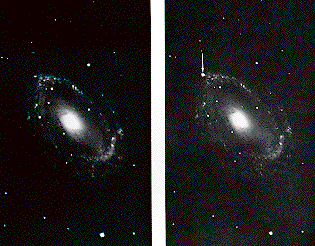
During 1940-41, a supernova explosion in NGC 4725 was observed at earth. (Kaufmann - Universe (4th ed) - Freeman 1994))
Some Cosmic Rays may be produced in Supernovae.

During 1940-41, a supernova explosion in NGC 4725 was observed at earth. (Kaufmann - Universe (4th ed) - Freeman 1994))
On 28 March 1993, supernova SN1993J in spiral galaxy M81, 11 million light-years away, was first observed on Earth. According to an article by Robert Roy Britt on the Space.com web site, the 7 January 200 issue of Science reported images
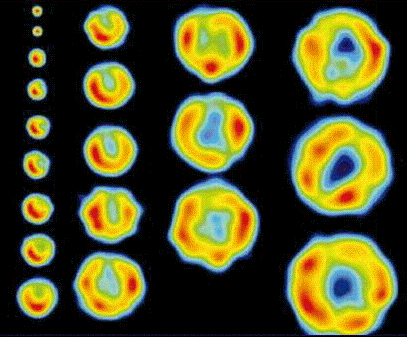
showing how SN1993J has expanded from September 1993 to September 1994, saying "... Norbert Bartel of York University in Canada and lead author of Science article ... told space.com that ... The star generating explosion, known as the progenitor star, was probably about 15 times the size of our sun ... Near the end of its life, the star had burnt all its fuel. ... The implosion generated an enormous shock wave that zoomed to the surface of the star and broke through on March 28, 1993. Spanish amateur astronomer Francisco Garcia Diaz spotted it. Within hours the supernova was billions of times brighter than our sun. The shock wave fled the scene at 12,427 miles each second (20,000 kps). "After 50 days the supernova has expanded to about 13 times the size of our planetary system," Bartel said. That's when the first image was taken, on April 27, 1993. (The event, being so far away, actually occurred a long time ago -- the light only began reaching us in 1993.) Even with a resolving power 100 times better than the Hubble telescope (using a global array of radio telescopes called the Very Long Baseline) no details were yet visible on the distant object, which lies in a relatively nearby galaxy called M81, roughly 12 million light-years away. Only the object's size could be measured. "After a half year first details became visible," Bartel said. "A round shell developed. But the shell was not uniformly bright; it was shining in kind of a horseshoe pattern. Furthermore this brightness pattern rotated with time." After two years, hot spots appeared around the outer edges. Researchers don't know why they occur, but Bartel thinks the shock wave may be catching up with knots of other material blown off the star thousands of years before it exploded. By this time, the shock wave's speed had decreased, and the deceleration itself increased with time. And by the time of the final image, on June 3, 1998, the shock wave moved at 5,282 miles-per-second (8,500 kps). ...".
According to a 30 June 2000 CNN article: "... Hubble images ...[showed]... that a gamma-ray burst and subsequent supernova occurred in an active star-forming region in one of the ... spiral arms ... in a galaxy only 125 million light years away ... One day after the burst on April 25, 1998, an unusually bright supernova took place in the exact same location. ...
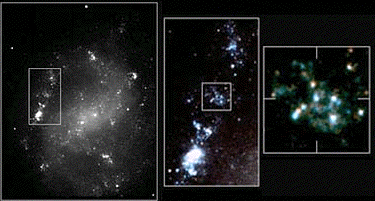
... This galaxy ... is actively forming stars in numerous gas clouds. The center image shows a star-forming area in one of the arms. The ...[right]... image shows the gamma-ray burst found within the area. ...".
According to a Chandra website article: "... A new 14 hour Chandra observation ... Observation time: 50,000 sec on 2000 Jan 30-31 ... of the supernova remnant Cassiopeia A has given the best map yet of heavy elements ejected in a supernova explosion.
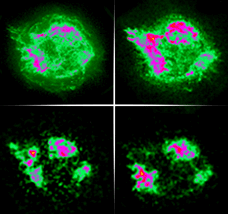
Upper left: Broadband X-ray image of Cassiopeia A (Cas A) Upper right: Image made by X rays from silicon ions. Lower left: Image made by X rays from calcium ions. Lower right: Image made by X rays from iron ions. All images are 8.5 arc minutes on a side (corresponding to 28.2 light years at a distance of 11,000 light years).
These images are designed to show the distribution of some of the elements ejected in the explosion that produced Cas A. The elements are part of a gas that has a temperature of about 50 million degrees Celsius. The colors represent intensity of X rays, with yellow the most intense, then red, purple, and green.
The broadband image, which shows all the X rays detected from Cas A, is more symmetric than the others. This could be due to the presence of X rays from synchrotron radiation by extremely high energy particles spiraling in the magnetic field of the remnant, or to shock waves traveling through material puffed off thousands of years before the supernova.
The silicon image shows a bright, broad jet breaking out of the upper left side of the remnant, and faint streamers in an opposite direction. This jet could be due to an asymmetry in the explosion.
The calcium image is similar to the silicon image, but less bright and clumpier.
The iron image shows significant differences from other images. Since iron is the heaviest element shown, these maps support the suggestion that the layers of the star were overturned either before or during the explosion. ...".
According to a 30 June 2000 space.com article by Dan Sorid: "... iron, the heaviest of the three elements, appears to have been expelled the farthest. ... "The model they had for this kind of explosion is that the star, before it explodedÖ, built up an onionskin layer with heavy elements [on the inside of the star]," ... Wallace Tucker ...[of]... the Chandra X-Ray Observatory Center in Cambridge ... said. "Somehow the iron got out ahead of everything." ... Another surprise is the way the star seems to be ejecting material mostly through a single jet, which appears on the upper-left of the pictures. ...".
Eta Cairnae can be seen from Earth in the southern sky between Alpha Centauri and Vela X, with the Southern Cross lying between it and Alpha Centauri:
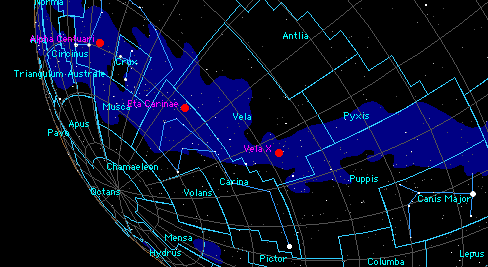
In the February 2000 issue of Astronomy, Robert Zimmerman writes: "... Eta Carinae ... has started brightening again, and no one knows why or where it might lead.
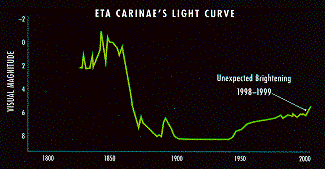
With about 120 times the mass of the sun, it comes close to the theoretical limit of how big a star can be. And although it lies 7,500 light-years away, the star glittered more brilliantly than any other star in the Galaxy between approximately 1835 and 1855. During this 20-year Great Eruption, it spit out two to three suns' worth of material. ... in 1994, the Hubble Space Telescope ... could look at the nebulosity surrounding the star and see its shape and detailed structure. ...
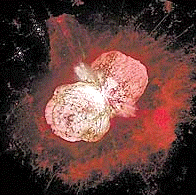
... The most obvious features in the Hubble images are the two large and grayish bipolar lobes, shaped somewhat like an hourglass. With a total mass somewhere around three times that of the sun, their glow comes mainly from starlight radiated by Eta Carinae that reflects off the ubiquitous dust in the lobes. Ejected from the star during the 1843 eruption, each lobe is expanding outward at the rate of about 1.5 million miles per hour. ... the lobes have expanded in 150 years to span about four trillion miles, or some 0.7 light-year. ... Less obvious but also seen first in the Hubble images was the strange equatorial disk tilted between 52° and 60° to our line of sight and about 90° to the two lobes. Faintly resembling a ceiling fan with many blades, the disk consists of many curious objects moving at a wide range of speeds. Three mysterious blobs appear embedded within the disk only a few light-days (about fifty billion miles) from Eta. Flying outward from the star at about 100,000 miles per hour, all three seem arranged around the outside edge of the equatorial disk's largest fan (called the Paddle and visible as the triangular-shaped bright area above and to the right of the Homunculus's center). Astronomers don't yet know what caused these blobs to erupt from the star so asymmetrically, though their speed and distance from the star suggest they were ejected in 1889. Within the Paddle itself, however, several small regions move at much slower speeds, as low as 30,000 miles per hour. These relatively sluggish speeds imply that the features were ejected from Eta several hundred years ago, long before the eruptions of the 19th century. The equatorial disk also contains several mysterious and fast-moving jets, or "bullets" as some scientists have labeled them. The northern jet is shooting away from the star at a tremendous velocity, estimated as high as 3.4 million miles per hour.... pushing its way through the interstellar medium of nitrogen gas that surrounds Eta Carinae and was ejected in a much earlier, unrecorded eruption. Although some scientists believe that the jet's origin is linked to the 1889 eruption, others contend that it - along with most of the equatorial disk - formed during the Great Eruption of 1843. ...
... X-rays reveal gas glowing at millions of degrees;
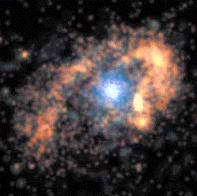
the horseshoe-shaped ring spans two light-years, while Eta inself apparently lies hidden in the central blue cloud ... (NASA/CXC/SAO ) ... When you point a telescope at Eta Carinae, you are looking down the length of our Galaxy's Carina-Sagittarius spiral arm, which traces a corkscrew around the galactic center and is home to some of the Milky Way's most massive stars and most glorious nebulae. In such spiral arms stars are born. Eta Carinae lies embedded in a dense giant molecular cloud only a few million years old, about 425 light-years across, and containing the mass of 10,000 suns.
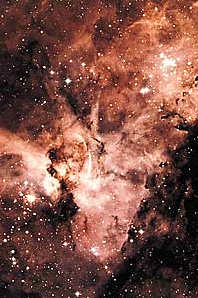
Anglo-Australian Telescope Board
Moreover, surrounding Eta Carinae's immediate environs are vast clouds of nitrogen and dust processed from hydrogen by the star's ... nuclear engine. ... massive stars like Eta Carinae ... not only process huge amounts of hydrogen fuel into more complex atoms such as carbon, oxygen, nitrogen, and iron, they also spray it out into the interstellar medium, accounting for a large percentage of the material found in the dense molecular clouds that surround them. Then, when such majestic stars go supernova, the explosion sweeps up this surrounding debris, forming a shock wave within which eventually flower the longer living but less massive ordinary stars - stars such as our sun. ...
... Eta Carinae ... belongs to a rare class of stars called Luminous Blue Variables, or LBVs, objects whose temperature and mass approach the absolute maximum believed possible for a star. Eta Carinae appears to tip the scales at a mass 100 to 120 times larger than the sun while its surface broils at a temperature that ranges between about 22,000° and 50,000° Fahrenheit. Compare this to the surface temperature of the sun, which comes in around 10,000° Fahrenheit. At its coolest, Eta Carinae also becomes most compact - though its size would still be large enough to swallow the orbit of Mercury if it replaced the sun. When the star's temperature rises, its radius swells and would reach the orbit of Mars or beyond. During the Great Eruption, the star probably expanded to a diameter of two billion miles, the size of Saturn's orbit. Moreover, astronomers think that Eta Carinae has one of the densest solar winds known, blowing off about 0.003 solar mass per year, some six trillion trillion tons, or two Earth masses each day. At this rate the sun would evaporate in a little more than three centuries. ... blue variables ... are thought to be a short-term transitional stage in the life of stars, spanning a mere 25,000 years or so. ... As the star sheds mass it slowly evolves from a blue supergiant to a Wolf-Rayet star, thought to be one of the last stages that stars reach before they die. Such stars have lost more than half to two-thirds of their original mass, have exhausted their hydrogen fuel, and now burn other, more complex atoms in their nuclear furnaces. Their next and final act, astronomers believe, is to explode as supernovae. ...
... "Without question, the central star has brightened since 1997 by roughly a factor of two," notes astrophysicist Jon Morse of the University of Colorado, whose Hubble images in June 1999 confirmed this brightening. And if the brightening trend continues, Morse adds that "in two years we will not be able to take an image with Hubble without saturating the camera. [Eta Carinae] will be too bright." ... The brightening is even more puzzling because it is occurring across all wavelengths. If the star were merely ejecting an outer shell in response to radiation pressure, the brightening would happen only at visible wavelengths, with the star's outer layers cooling and its output shifting from the ultraviolet to the optical. An increase in brightness across the entire electromagnetic spectrum implies that Eta is growing intrinsically brighter, a possibility no theory predicted. Moreover, this brightening implies that the star's luminosity may soon overwhelm its gravity, once again causing the star to become unstable and erupt as it did in the last century. ... [Michael Corcoran of the Universities Space Research Association] recently said that "The death of Eta Carinae is likely to be one of the most explosive events ever experienced in the Galaxy." When such massive stars go supernova, the energy released can be so powerful that it equals and possibly exceeds that of the rest of the Galaxy. ...".
Since photons and neutrinos from a SuperNova explosion of Eta Carinae would take about 7,500 years to get to Earth,
In astro-ph/0110162, Arnon Dar and A. DeRujula say: "... Eta Carinae, the most massive and luminous star known in our galaxy ... more than 100 times as massive and 5 million times as luminous as the Sun ... is rapidly boiling matter off its surface. At any time its core could collapse into a black hole, which may result in a gamma-ray burst (GRB) that can devastate life on Earth. ...
... Should the violent end of Eta Carinae, ... only D = 2 kpc away, emit in our direction a GRB similar to that of the most energetic GRB ... (GRB 990123), the atmosphere of Earth facing the star would be subject to a total energy deposition:
within seconds. This energy release is akin to that of the simultaneous explosions in the upper atmosphere of one-kiloton of TNT per km^2 , over the whole hemisphere facing Eta Carinae. This would destroy the ozone layer, create enormous shocks going down in the atmosphere, lit up huge fires and provoke giant global storms.
If the energy of GRBs in TeV gamma-rays, as indicated by various experiments ... , is [about] 100 times larger than in the sub-MeV domain, the energy deposition ... would be correspondingly larger. Moreover, the interactions of the TeV -rays in the upper atmosphere would produce a lethal dose of highly penetrating muons, destroying life on the surface, underground and underwater. ... the total muon fluence at ground level expected from a GRB from the supernova death of Eta Carinae is [about] 5 x 10^10 cm^(-2) (the roughly linear dependence on the -ray energy makes this result sensitive only to the total deposited energy). The energy deposition by these high-energy muons in biological materials is [about] 2.5 x 10^5 erg g^(-1) , which is about ten times the lethal dose for human beings: the whole-body dose from penetrating ionizing radiation resulting in 50% mortality in 30 days ...
... Auspiciously, recent observations indicate that the GRBs are narrowly beamed in cones along the rotational axis of the progenitor star. In the case of Eta Carinae the GRBs will not point to us, but will be ravaging to life on planets in our galaxy that happen to lie within the two beaming cones. ...
... The average energy output of a GRB is 5 times smaller than that of GRB 990123 ... The average distance of galactic GRBs from Earth, assuming they have the same spatial distribution as supernova remnants, is [about] 8 kpc. Gamma rays alone from such "typical" GRBs can barely cause major mass extinctions, since the frequency of such GRBs is too small to explain a mean rate of mass extinctions of once in [about] 100 My, observed in the geological records ... However, if GRBs are produced in supernova explosions by highly relativistic jets of "cannonballs", as suggested by the striking success of the Cannonball Model of GRBs in explaining their afterglows ... the jetted cannonballs also produce highly beamed cosmic rays (CRs) by ionizing, sweeping up and accelerating the particles of the interstellar medium (ISM). Such CRs from galactic GRBs are much more devastating than their gamma-rays. ... the CR beam sweeps away the magnetic field along its way and follows a straight ballistic trajectory through the interstellar medium. (The corresponding argument, when applied to the distant cosmological GRBs, leads to the opposite conclusion: no CRs from distant GRBs escort the gamma rays in their voyage.) The beam of multi-TeV cosmic rays accompanying a galactic GRB is deadly for life on Earth-like planets. ... The lethal dosages for other vertebrates and insects can be a few times or as much as a factor 20 larger [than for humans], respectively. Hence, CRs from galactic GRBs can produce a lethal dose of atmospheric muons for most animal species on Earth. Because of the large range of muons ... their flux is lethal, even hundreds of metres underwater and underground, for CRs arriving from well above the horizon. Thus, unlike other suggested extrater- restrial extinction mechanisms, the CRs of galactic GRBs can also explain massive extinctions deep underwater and underground. ...
... The mean rate of massive life extinctions by jets from GRBs, per life-supporting planet in galaxies like ours, is once in 100 million years, comparable to the rate of major extinctions observed in the geological records of our planet.
GRB extinctions also provide an answer to Fermi's question about alien visitors: "Where are they?" ... even if advanced civilizations are not self-destructive, GRBs can exterminate the most evolved species on any given planet or interstellar vehicle at a mean rate of once every 100 My. Consequently, there may be no nearby aliens having evolved long enough to be capable of communicating with us, or pay us a visit. ...".
The Distance to the Vela Supernova Remnant was measured by Cha, Sembach, and Danks, who reported in astro-ph/9902230 that "... The analysis of a significant sample of O and B stars in the direction of the Vela SNR has enabled a direct distance measurement of 250 +/-30 pc, with a conservative upper limit of 390 +/- 100 pc. ...". They also state the following attributes of Vela SNR at 250 +/- 30 pc:
People on earth saw the explosion about 11,000 years ago as a star of magnitude -10, as bright as a 7-day old Moon.
Johnston, van Straten, Kramer, and Bailes, in their paper astro-ph/0101146, say:
"... We present high time resolution observations of single pulses from the Vela pulsar (PSR B0833&endash;45) made with a baseband recording system at observing frequencies of 660 and 1413 MHz. We have discovered two startling features in the 1413 MHz single pulse data.
- The first is the presence of giant micro-pulses which are confined to the leading edge of the pulse profile. One of these pulses has a peak flux density in excess of 2500 Jy, more than 40 times the integrated pulse peak.
- The second new result is the presence of a large amplitude gaussian component on the trailing edge of the pulse profile. This component can exceed the main pulse in intensity but is switched on only relatively rarely. Fluctutation spectra reveal a possible periodicity in this feature of 140 pulse periods. Unlike the rest of the profile, this component has low net polarization and emits predominantly in the orthogonal mode. This feature appears to be unique to the Vela pulsar.
We have also detected microstructure in the Vela pulsar for the first time. These same features are present in the 660 MHz data. We suggest that the full width of the Vela pulse profile might be as large as 10 ms but that the conal edges emit only rarely. ...".
According to Wijers and Sugurdsson, in their paper astro-ph/9704225, the Vela supernova pulsar may have had a binary companion neutron star that is now ploughing a channel through the supernova remnant cloud, creating an X-ray feature that is asymmetric with respect to the supernova remnant cloud.
The neutron star binary companion to the Vela supernova pulsar may, as it is a neutron star, be the remnant neutron star of the supernova of about 3 to 10 million years ago that formed the Gum Nebula, which now from Earth looks like a shell with radius about 20 degrees. In comparison (see Kaufmann - Universe (4th ed) - Freeman 1994), the sun and moon each cover about half a degree.
Now, the Vela supernova remnant is expanding into the old remnant of the Gum supernova.
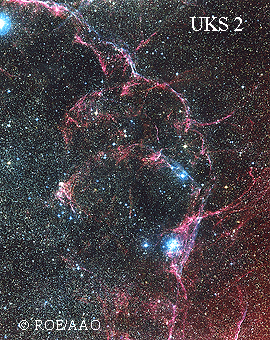
According to Timothy Ferris (Coming of age in the Milky Way, William Morrow & Co. 1988) the Sumerians, who were living on the plains of the Tigris-Euphrates, identified the supernova with their god Ea, who invented writing and agriculture, and the Egyptians identified it with their goddess Seshat, the principal wife of Thoth, and may have represented it by the Great Pyramid at Giza. According to the book An Adventure in Multidimensional Space by Koji Miyazaki (Wiley 1986), the city plan of Beijing has 5 elements: a square Altar of Earth in the North; a square Palace Museum in the Center; a circular Altar of the Sun in the East; a semicircular Altar of the Moon in the West; and a circular Altar of Heaven in the South. Could the circular Altar of Heaven have been located in the South to correspond to the Southern sky where the Vela X supernova had appeared?
Could the Flaming Pearl sought by the Dragon
(from Palace Museum Peking, by Weng and Boda (Abrams 1982))
represent the Vela X supernova?
VELA X and COMETS:
The Vela X supernova may have roughly coincided
with the primary breakup of a large parent comet
of Comet Encke and the Taurid meteors.
Could radiation from the Vela X supernova have
heated the dark surface of comets in the Oort cloud,
creating jets of gas and dust,
so perturbing the orbits of the comets,
and causing the large Encke/Taurid parent comet to
enter the inner solar system and
break up when it encountered more intense solar radiation?
If Sitchin's Sumerian Solar System body Nibiru,
with period (as known to the Sumerians) of roughly 3600 years,
were a Comet, then maybe it could have been Comet Hale-Bopp
(a conjecture that came from e-mail discussion with Ron Nye).
Since the last period of Comet Hale-Bopp was about 4200 years,
if its preceding two periods were each about 3600 years,
then Hale-Bopp would have had a perihelion about 11,400 years ago,
which is about the time of the Vela X supernova.
Therefore, it is possible that Comet Hale-Bopp
could have been affected by supernova Vela X.
VELA X and the SUN:
Could radiation from the Vela X supernova, particularly neutrinos,
have changed rates of Solar nuclear reactions involving nuetrinos
and so have increased the Sun's luminosity?
Could such increased Solar luminosity have
perturbed the comets in the Oort cloud?
VELA X and the EARTH'S CLIMATE:
Could Vela X, by either
dust or impacts from comet/meteor fragments
of the Encke/Taurid parent comet,
or
altered Solar luminosity,
have affected the Earth's climate,
contributing to the melting of the glaciers
at the beginning of the Holocene Age?
In his book Rogue Asteroids and Doomsday Comets (John Wiley, 1995),
Duncan Steel says a majority view of the consequences to Earth
of major comet/meteor impact is that:
1 - for weeks, radiated heat (and impact heat) would heat up
the Earth, causing global fires, which in turn would
put a lot of soot and CO2 into the atmosphere;
2 - for years, atmospheric soot, dust, and pulverized rock would
reflect sunlight, causing a Cosmic Winter.
3 - for thousands of years, atmospheric CO2 would heat the Earth
through the greenhouse effect.
perhaps then 300 light years away from Earth, could have exploded about 340,000 years ago, the time of the Neanderthals, with radiation reaching earth shortly thereafter and shockwave reaching Earth about 35,000 years ago, the time of the Cro-Magnons.
According to a 10 May 2001 PhysicsWeb article:
"... (J. W Beck et al 2001 Science to appear) ...Beck and colleagues tested slices of a half-metre long stalagmite that grew between 45 000 and 11 000 years ago in a cave in the Bahamas. Stalagmites are calcium carbonate deposits left behind when carbon dioxide evaporates out of cave seepage water. They found that carbon-14 concentrations were twice their modern level during that period. Current records of the levels of carbon-14 in the atmosphere only cover the last 16 thousand years, and this discovery extends those records a further 30 thousand years. Galactic cosmic rays create most of the carbon-14 in our atmosphere, while solar cosmic rays generate a smaller fraction. The Earth is partially shielded from galactic cosmic rays by its own magnetic field and the solar magnetic field, which fluctuates as the solar cycle proceeds. But these effects are predictable and are thought to have changed little in the last million years - which means they cannot explain the glut of carbon-14. Evidence from North Atlantic sediments suggests that the Earth's magnetic field may have dipped around 40 thousand years ago, but this would still only account for - at best - half of the observed peak in carbon-14 concentrations. Beck's team concludes that either a jump in the cosmic ray flux or a fundamental change in the carbon cycle must have produced the sudden increase of carbon-14. The team speculates that a supernova shock wave could have produced a flurry of cosmic rays. "Weaker circulation of the oceans - which are the biggest reservoirs of carbon on Earth - would explain the excess of carbon-14", David Richards, joint team leader, told PhysicsWeb. If carbon-14 is carried more slowly from the surface to the depths of the ocean, he explains, the carbon-14 content of the atmosphere will rise. ... Carbon dating is a mainstay of geology and archaeology - but an enormous peak discovered in the amount of carbon-14 in the atmosphere between 45 thousand and 11 thousand years ago casts doubt on the biological carbon cycle that underpins the technique. ... ".
The Geminga supernova could have created the Local Bubble,
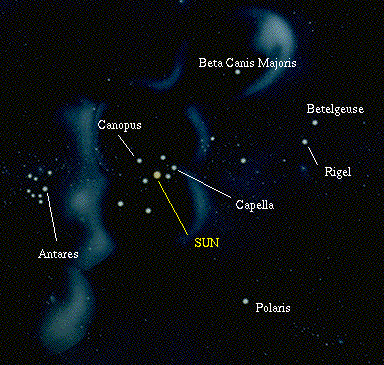
which is roughly elliptical in shape and whose size is on the order of about 300 light years across its short axis and 1,000 light years across (1 light year = 63,240 AU). (See Kaufmann, Astronomy (4th ed), Freeman 1994.),
and
could be responsible for the knee of the Cosmic Ray Energy Spectrum.
Near Geminga, in the region of the anticenter of the Milky Way, is the
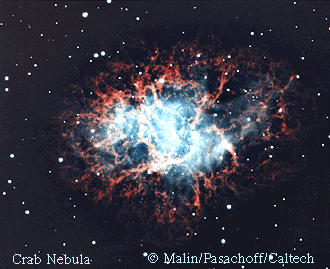
Here is a Chandra X-ray picture of the Crab Nebula:
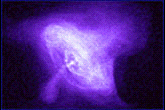
The Crab Nebula and its pulsar
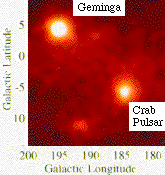
were created by a supernova that exploded about 7,500 years ago. Since it is about 6,500 light years away, it was not seen on Earth until about 1,000 years ago, on 4 July 1054 AD.
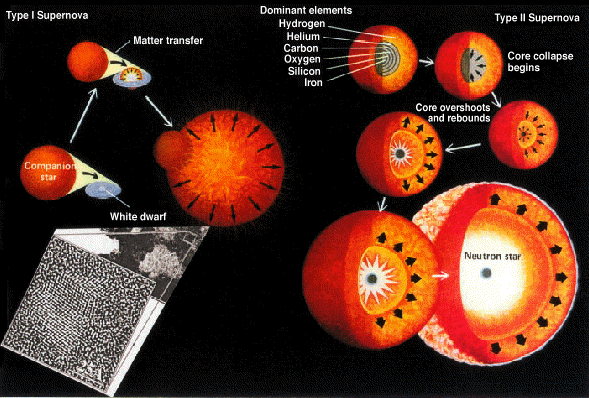
According to a paper by Stephen E. Haggerty in Science 285 (6 August 1999) 851-860: "... On final implosion and rebounding, the outermost envelopes are blasted into the interstellar media. It is in these outermost expanding and cooling envelopes of type I and type II SN that nanodiamonds nucleate, perhaps a month or so after a SN event. This is shown schematically by the inset, which is an electron image of a presolar diamond from the Murchison meteorite. ... [The above image is adapted] ...by courtesy of Encyclopaedia Brittanica, Inc. Copyright Encyclopaedia Brittanica Yearbook of Science and the Future 1989. ...". Diamond tetrahedral structure is shared by water ice.
According to a 10 April 2002 AP article in The New York Times:
"... An orbiting X-ray telescope has found two bizarre objects that may form a new star class ... The objects, called RXJ1856 and 3C58, were thought to be neutron stars, but observations by NASA's Chandra X-ray telescope show that they are too small and too cold to be standard neutron stars. ... RXJ1856 has a temperature of about 1.2 million degrees, too cool for a neutron star, and a diameter of about seven miles, much smaller than the standard. Yet the measurements show that the object has the mass and X-ray emissions of a larger neutron star. ... Conventional theory tells us this object should be a neutron star, comprised entirely of neutrons, with a diameter of about 12 to 20 miles in size ...The smaller size suggests that the object is much more dense, perhaps dense enough to shatter its neutrons and set free the quarks they contain. ...... 3C58, the neutron star remnant of a supernova observed in the year 1181 by Chinese and Japanese astronomers, ...[was found]... to be much cooler than expected. ... for a 820-year-old star, the temperature should be a little under 2 million degrees (3.6 million degrees Fahrenheit) and the surface should be glowing in X-rays and emitting about four times as much energy per second as the sun ... observations show that the temperature is far lower than that and the radiation is down by at least a factor of ten. ... in a neutron star, theory predicts a density equal to about a billion tons per teaspoon of matter ... even this density is not enough to squeeze (heat) out fast enough to produce the cool star that we see. ... the astronomers conclude the density of 3C58 is higher than a neutron star and may reach three to five times the density of nuclear matter, forming a new state of matter. ...
... the findings ... are consistent with the theory that neutrons in a star can be broken apart under extreme density to form a smaller, quark star. ...".
......